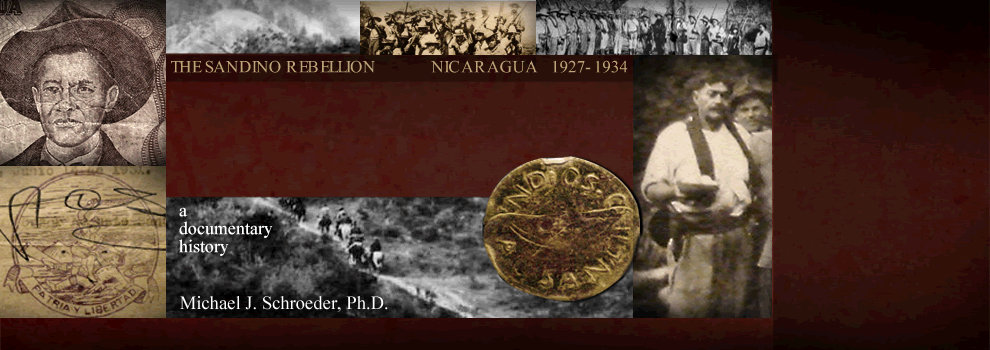|
Jinotega, Nicaragua.
24 April 1929.
From: The
Commanding Officer
To: B-2, Second Brigade Marines, Managua, Nicaragua.
District Commander, Matagalpa, Nicaragua.
R-2, Fifth Regiment
Subject: Information of recent
bandit movements.
1. Felipe Zelaya, Mandador of La
Union finca, property of Josefa Pineda Castellon
located S.W. of Colonia and Santa Isabel, near
the Rio Tuma, states that he was captured by a
group of about 20 bandits led by Cornejo
[Lieutenant Florencio Cornejo] at Union Finca
about 1830 April 10th, 1929 and taken to San
Lucas Finca, about one kilometer to the south
where they came upon Altamirano and about 10
men. He was then confined for the night but
early the next morning, the 11th, he saw about
100 men assembled at San Lucas. These were
divided into four companies, three of which were
armed with rifles and pistols, while the fourth
carried the provisions, machetes and ropes. The
band separated and proceeded north, avoiding
trails and keeping on high ground. The armed
groups were led by Altamirano, Sebastian
Centeno, Cornejo [Florencio Cornejo], one group
had a Lewis gun and each of the others a
Thompson. Altamirano himself carried the
Thompson also two Colt 38's and a dagger. He,
Zelaya, was held with Altamirano group which
consisted of about 12 men. Zelaya states they
passed between La Colonia and Pena Blanca and
camped in the forest near Las Cuchillas on the
night of Apr. 11-12 and he was released the
morning of the 12th. The conversation among the
men was to the effect that they intended joining
with Sandino and that they would continue as
bandits while American forces were in Nicaragua.
Zelaya states that when airplanes came over on
the 11th they halted and remained motionless,
while several of the band played guitars and
sang songs. During the time he was with them,
the bandits avoided all houses, clearings and
trails.
2. Maria Siles, widow of Emilio
Siles, who was killed on the morning of April
14, 1929, near his home at Las Cruces, states
that Altamirano with a force of bandits had
visited their home on 31 Jan, 29, taken clothing
and captured her husband and kept him prisoner
for two (2) days but had released him after
inquiring as to whether he was a spy for
Moncada. He came again about Mar. 10, but her
husband was not home. On the morning of April
14th, a band came to their house and took their
clothing, blankets and about $80.00 in cash.
They also said her husband was a spy and took
him, her two (2) sons Isais and Sylvester and a
laborer, Salinas as prisoners.
3. Isais Siles states he was taken
prisoner by a band headed by Sebastian Centeno
at about 0700 April 14, 1929 at Las Cruces and
released early on the morning of 15 April near
Paso Real, Altamirano was not with this band
during this time. Centeno led the band which was
divided into three (3) groups one of which was
led by a man named / p. 2 / Rodriguez, all were
armed with rifles and nearly all had pistols.
Centeno's group led and one man in this group
carried a Lewis Machine Gun, the other two
groups each had a Thompson which was carried by
a man about the center of the group. They
marched in pairs with about 50 meters or more
between groups. Siles states he could not see
whether any men were ahead of the column as a
point but he felt sure they had no one on the
flanks. They marched on high ground and avoided
trails and clearings. On the night of 14-15
April they camped in the forest, the force
divided into five (5) groups, Centeno with one
group of about ten (10) bandits and the
prisoners occupied the center. Each group put
out one (1) sentry who was relieved every hour.
4. Sylvester Siles states
substantially the same as his brother, except he
estimates about eighty (80) bandits instead of
fifty (50). He and his father were turned over
to the leader of the rear group and after
proceeding about 1000 meters from their home
Centeno gave a paper to the leader of this
group. He, the leader whose name is not known
detailed two (2) men from the group to take his
father out of the column and kill him. The
column was not halted. The two men took his
father off the trail and killed him with
machetes. He also stated that two men followed
the column far to the rear.
5. Lieut. Hamas, G.N. stated that
while en route from Santa Cruz to Jinotega, a
farmer about five miles south of Guali told him
that about fifty (50) bandits had passed north
on the hills west of Sta Maria Valley on April
17th. On the same day, the 17th, a native
reported to him, Lt. Hamas at Sta Cruz that
about fifteen (15) bandits crossed the Coco
River that evening, near Las Piedras, headed
north.
6. No definite information has been
received as to where Altamirano himself went
after 12 April.
/s/
A. E. Simon
M29.04.24. RG127/43A/24.
Excerpt in IR29.05.13, NA127/209/1
|

